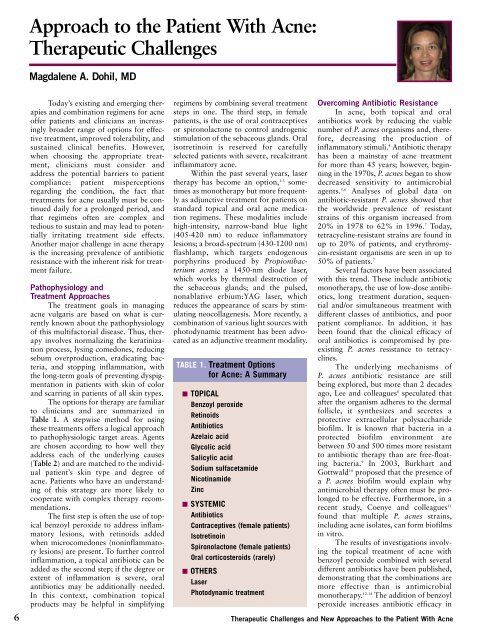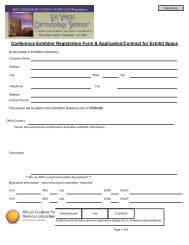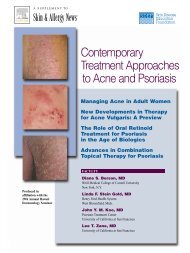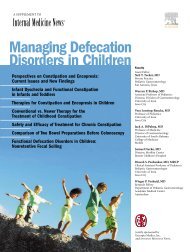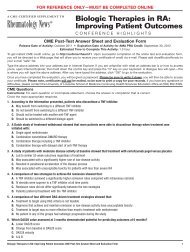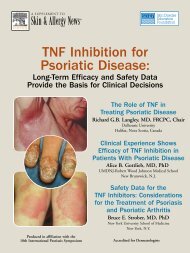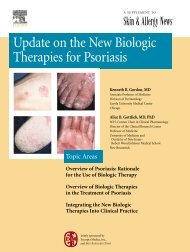Skin & Allergy News® - Global Academy for Medical Education
Skin & Allergy News® - Global Academy for Medical Education
Skin & Allergy News® - Global Academy for Medical Education
Create successful ePaper yourself
Turn your PDF publications into a flip-book with our unique Google optimized e-Paper software.
Approach to the Patient With Acne:<br />
Therapeutic Challenges<br />
Magdalene A. Dohil, MD<br />
Today’s existing and emerging therapies<br />
and combination regimens <strong>for</strong> acne<br />
offer patients and clinicians an increasingly<br />
broader range of options <strong>for</strong> effective<br />
treatment, improved tolerability, and<br />
sustained clinical benefits. However,<br />
when choosing the appropriate treatment,<br />
clinicians must consider and<br />
address the potential barriers to patient<br />
compliance: patient misperceptions<br />
regarding the condition, the fact that<br />
treatments <strong>for</strong> acne usually must be continued<br />
daily <strong>for</strong> a prolonged period, and<br />
that regimens often are complex and<br />
tedious to sustain and may lead to potentially<br />
irritating treatment side effects.<br />
Another major challenge in acne therapy<br />
is the increasing prevalence of antibiotic<br />
resistance with the inherent risk <strong>for</strong> treatment<br />
failure.<br />
Pathophysiology and<br />
Treatment Approaches<br />
The treatment goals in managing<br />
acne vulgaris are based on what is currently<br />
known about the pathophysiology<br />
of this multifactorial disease. Thus, therapy<br />
involves normalizing the keratinization<br />
process, lysing comedones, reducing<br />
sebum overproduction, eradicating bacteria,<br />
and stopping inflammation, with<br />
the long-term goals of preventing dyspigmentation<br />
in patients with skin of color<br />
and scarring in patients of all skin types.<br />
The options <strong>for</strong> therapy are familiar<br />
to clinicians and are summarized in<br />
Table 1. A stepwise method <strong>for</strong> using<br />
these treatments offers a logical approach<br />
to pathophysiologic target areas. Agents<br />
are chosen according to how well they<br />
address each of the underlying causes<br />
(Table 2) and are matched to the individual<br />
patient’s skin type and degree of<br />
acne. Patients who have an understanding<br />
of this strategy are more likely to<br />
cooperate with complex therapy recommendations.<br />
The first step is often the use of topical<br />
benzoyl peroxide to address inflammatory<br />
lesions, with retinoids added<br />
when microcomedones (noninflammatory<br />
lesions) are present. To further control<br />
inflammation, a topical antibiotic can be<br />
added as the second step; if the degree or<br />
extent of inflammation is severe, oral<br />
antibiotics may be additionally needed.<br />
In this context, combination topical<br />
products may be helpful in simplifying<br />
regimens by combining several treatment<br />
steps in one. The third step, in female<br />
patients, is the use of oral contraceptives<br />
or spironolactone to control androgenic<br />
stimulation of the sebaceous glands. Oral<br />
isotretinoin is reserved <strong>for</strong> carefully<br />
selected patients with severe, recalcitrant<br />
inflammatory acne.<br />
Within the past several years, laser<br />
therapy has become an option, 1-3 sometimes<br />
as monotherapy but more frequently<br />
as adjunctive treatment <strong>for</strong> patients on<br />
standard topical and oral acne medication<br />
regimens. These modalities include<br />
high-intensity, narrow-band blue light<br />
(405-420 nm) to reduce inflammatory<br />
lesions; a broad-spectrum (430-1200 nm)<br />
flashlamp, which targets endogenous<br />
porphyrins produced by Propionibacterium<br />
acnes; a 1450-nm diode laser,<br />
which works by thermal destruction of<br />
the sebaceous glands; and the pulsed,<br />
nonablative erbium:YAG laser, which<br />
reduces the appearance of scars by stimulating<br />
neocollagenesis. More recently, a<br />
combination of various light sources with<br />
photodynamic treatment has been advocated<br />
as an adjunctive treatment modality.<br />
TABLE 1. Treatment Options<br />
<strong>for</strong> Acne: A Summary<br />
TOPICAL<br />
Benzoyl peroxide<br />
Retinoids<br />
Antibiotics<br />
Azelaic acid<br />
Glycolic acid<br />
Salicylic acid<br />
Sodium sulfacetamide<br />
Nicotinamide<br />
Zinc<br />
SYSTEMIC<br />
Antibiotics<br />
Contraceptives (female patients)<br />
Isotretinoin<br />
Spironolactone (female patients)<br />
Oral corticosteroids (rarely)<br />
OTHERS<br />
Laser<br />
Photodynamic treatment<br />
Overcoming Antibiotic Resistance<br />
In acne, both topical and oral<br />
antibiotics work by reducing the viable<br />
number of P. acnes organisms and, there<strong>for</strong>e,<br />
decreasing the production of<br />
inflammatory stimuli. 4 Antibiotic therapy<br />
has been a mainstay of acne treatment<br />
<strong>for</strong> more than 45 years; however, beginning<br />
in the 1970s, P. acnes began to show<br />
decreased sensitivity to antimicrobial<br />
agents. 5,6 Analyses of global data on<br />
antibiotic-resistant P. acnes showed that<br />
the worldwide prevalence of resistant<br />
strains of this organism increased from<br />
20% in 1978 to 62% in 1996. 7 Today,<br />
tetracycline-resistant strains are found in<br />
up to 20% of patients, and erythromycin-resistant<br />
organisms are seen in up to<br />
50% of patients. 7<br />
Several factors have been associated<br />
with this trend. These include antibiotic<br />
monotherapy, the use of low-dose antibiotics,<br />
long treatment duration, sequential<br />
and/or simultaneous treatment with<br />
different classes of antibiotics, and poor<br />
patient compliance. In addition, it has<br />
been found that the clinical efficacy of<br />
oral antibiotics is compromised by preexisting<br />
P. acnes resistance to tetracyclines.<br />
The underlying mechanisms of<br />
P. acnes antibiotic resistance are still<br />
being explored, but more than 2 decades<br />
ago, Lee and colleagues 8 speculated that<br />
after the organism adheres to the dermal<br />
follicle, it synthesizes and secretes a<br />
protective extracellular polysaccharide<br />
biofilm. It is known that bacteria in a<br />
protected biofilm environment are<br />
between 50 and 500 times more resistant<br />
to antibiotic therapy than are free-floating<br />
bacteria. 9 In 2003, Burkhart and<br />
Gottwald 10 proposed that the presence of<br />
a P. acnes biofilm would explain why<br />
antimicrobial therapy often must be prolonged<br />
to be effective. Furthermore, in a<br />
recent study, Coenye and colleagues 11<br />
found that multiple P. acnes strains,<br />
including acne isolates, can <strong>for</strong>m biofilms<br />
in vitro.<br />
The results of investigations involving<br />
the topical treatment of acne with<br />
benzoyl peroxide combined with several<br />
different antibiotics have been published,<br />
demonstrating that the combinations are<br />
more effective than is antimicrobial<br />
monotherapy. 12-14 The addition of benzoyl<br />
peroxide increases antibiotic efficacy in<br />
6 Therapeutic Challenges and New Approaches to the Patient With Acne


